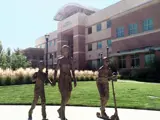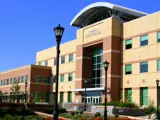Vibrant Community
Comprehensive Plan: Chapter 5
Overview
Community design focuses on aspects of the built environment that add enduring value to the community. Thoughtfully designed community spaces improve the livability and quality of life for current and future generations of Meridian residents. Without intentional and context-oriented design to promote neighborhood reinvestment, vibrancy, and social interactions, the city could lose sight of its unique character.
A Vibrant Community is built on creative design that integrates past and future. As Meridian becomes one of the larger cities in the West, the Plan encourages the creation of well-designed places that will serve generations to come. Arts, community events, cultural assets, and celebrations can play a critical role in making Meridian a vibrant and beloved place with a distinct, engaging identity. The Plan focuses on enhancing and improving the built environment, contributing value to Meridian’s sense of place and reinforcing community identity through redevelopment areas that incorporate amenities and gathering places. The Plan stresses encouraging creativity and high-quality in new neighborhoods and commercial areas. The Plan identifies tools for implementation so that neighborhoods, gateways, corridors, public spaces, and commercial areas represent community values through thoughtful design and strategic building placement, materials, and signage. The community also seeks authenticity within places; the Plan’s historic preservation element underscores the importance of heritage by directing the preservation, restoration, celebration, and memorialization of sites/buildings with historical or cultural relevance. The Plan transcends all these elements with arts and culture, which brings enrichment to the community and reinforces sense of place.
As part of the Vibrant Community Vision, the following elements are included in this chapter:
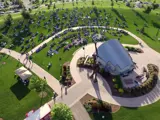
Character, Design and Identity
Introduction
The Character, Design, and Identity element focuses on protecting, enhancing, and improving the unique features of the natural and built environment that contribute value to Meridian’s quality of place. From residential areas to retail centers, business parks to open space, the community should look and feel intentional. Neighborhoods, neighborhood centers, and commercial developments should be both grounded and unique, incorporating features of their surroundings while offering residents, visitors, and employees distinctive, safe, and inviting environments.
Gathering places should be convenient and integrated, encourage social activity and engagement through generous and intentional amenities and activation, and be a cornerstone of community pride and timeless neighborhood value. Policy decisions reflect Meridian’s desire for quality and aesthetic design that reinforces the community’s identity, instills community pride, and is built to last.
Background
The inherent goal of community design is to prioritize and improve livability and quality of life for current and future generations of Meridian residents. For the purpose of this Plan, community design refers to both residential and non-residential layout and building design, transition, and buffers. Moreover, community design is inextricably linked to sustainability, livability, healthy initiatives, as well as other elements of this Plan.
Community design also involves preserving and enhancing unique and extraordinarily valuable areas or attributes of the City; community design provides a means to maintain the unique characteristics of the City and to improve the built environment.
Subdivision Design
The foundation of ensuring good Community Design principles is largely accomplished through the City’s subdivision review and approval process. This process involves the entitlement of land for division through a public hearing process. While land use is an integral component of the development process (see Chapter 3), equally if not more important is the role of the Subdivision Design and Improvement Standards, Common Open Space and Amenity Requirements, and other supporting development standards contained in Title 11 of Meridian City Code, in supporting the vision and intent of the Comprehensive Plan.
These sections of City Code should be continually re-examined and updated as needed to enable and implement the vision and policies in the Comprehensive Plan related to the general location and configuration of all development types to be realized. Subdivision review and approval establishes future road configurations, access locations, lot layouts, areas and amounts of open space, and serves as a prelude to subsequent administrative design review.
Building and Site Design
The City requires Certificate of Zoning Compliance and Administrative Design Review approval prior to construction of any new building (except single-family). This process typically occurs after subdivision approval. The Architectural Standards Manual (ASM) and Title 11 of City Code are the primary tools used in this process. The ASM provides the City with a standards based tool to guide the creation of attractive, lasting, and quality-built environments that contribute to the progression of Meridian as a livable community. This process ensures that development complies with all of the provisions of City Code as well as encouraging high quality building construction that employs the use of good design principles to produce attractive developments with unique character and that are appropriate for existing district identities. Some in the community have voiced concern about the design and character of buildings and integration of some projects into the community. Thoughtful design of commercial and residential developments can have a positive or negative effect on community pride, city character, and economic vitality. The City should explore ways to improve the building and site design review process. Building permit review follows the Certificate of Zoning Compliance process, ensuring life safety standards are met regarding building construction.
Entryway Corridors and Gateways
Meridian welcomes residents and visitors into the community through designated entryway corridors and gateways. It is the community’s intent to require additional landscaping and entryway features at these locations. This includes elevated building façades, parking lot layout, and public space design. Artistic features and public art can also enhance the overall character of a gateway. The goal of entryway and gateway design standards is to make a positive impression on visitors and instill community pride in residents. Gateways will inspire people to live, work, play, and stay in Meridian.
The City has also established a plan for welcoming residents and visitors into the community with welcome signage. In combination with entryway and gateway requirements, these signs have a significant effect on visitors’ first impression of the City. See the List of Adopted Plans and Studies by Reference for more information.
Signs
Signs are an invaluable source of providing direction and maintaining optimal mobility through a city. They can also provide advertising, and marketing, and contribute to community identity. Signs will not be a distraction to motorists or pedestrians, or otherwise present a safety hazard by interfering with line-of-sight, blocking traffic control devices, or hampering traffic flow. By complementing building design and landscaping, signs will integrate aesthetically into the community. Sign regulations must ensure there is balance between safety, advertising, communication, architectural elements, aesthetics, and free speech.
Sustainability
The fundamentals of sustainability within local government center on creating balanced solutions; solutions that deliver services at levels citizens expect in an environmentally, economically, and socially responsible way. These fundamentals interact in the process of balancing the needs of protecting and enhancing the economy, the natural environment, and the built environment. By utilizing industry standard best practices, quality design standards, and project commissioning, the City can quantify and verify that tax and rate payers are paying for facilities and infrastructure that enable sustainable and livable neighborhoods.
"New investment is increasingly seeking locations based on the quality of place rather than the utility of location." - Steve McKnight, Fourth Economy Consultants
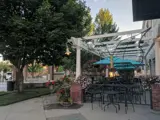
Historic Preservation
Introduction
The Historic Preservation element underscores the importance of preserving Meridian’s heritage by remembering previous generations who laid the foundation for Meridian today. Policies not only direct the preservation and restoration of sites/buildings with historic or cultural relevance, but also how to celebrate and memorialize them.
Background
Meridian has a unique, storied history. Preserving that history is important because it defines the roots of the community and provides a sense of belonging to residents who treasure it.
Some Meridian properties are on the National Register of Historic Places, but there are many additional historical resources and architectural features within the city limits and the Area of City Impact that are not yet listed on this Registry. Although they may not be listed on the National Registry, they still carry historical and cultural significance to Meridian. Meridian’s important agricultural heritage and history of town settlement is reflected in the many private historic residences and commercial buildings within the area. However, continued urban expansion and development have threatened some of these sites over the years.
While many of these sites and features have been lost, and others can no longer be realistically preserved, they can still be remembered. To preserve the memory and significance of these sites, all viable resources such as photos, models, written and oral stories, and memorabilia or significant artifacts should be used to pay tribute to a site’s important role in shaping Meridian history. The design of new structures and landscapes can also acknowledge and celebrate Meridian’s heritage by incorporating art and/or learning experiences for youth.
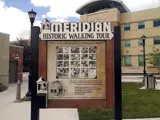
Arts and Culture
Introduction
The Arts/Culture element reinforces the City’s vision for a vibrant arts and entertainment scene that integrates the arts experience into everyday life and enhances the spirit of the City.
Background
As part of its commitment to raising awareness of existing opportunities and providing new offerings to experience art, the Meridian Arts Commission (MAC) provides the community with visual, performing, and musical arts opportunities throughout the year. MAC ensures continued access to a variety of offerings for all residents, regardless of age, race, or ability.
In addition to supporting the arts, the City will continue to encourage community events and annual programs that are vital to the community’s well-being. Maintaining a variety of social opportunities is essential in promoting community for all residents; the City supports the exploration of other opportunities to support new facilities for community enrichment, education, and outreach.
Through Meridian’s Art in Public Spaces Ordinance and community partnerships, major public art pieces have been installed throughout Meridian—in Downtown, in several parks, and in city buildings. The visual arts, performing arts, community events, and Meridian’s heritage are integral components of the community’s identity. The sense of community is evident in many celebrations and events, neighborhoods, and public institutions.
